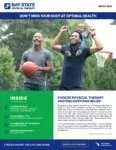Understanding TMJ and the Role of Physical Therapy in Treatment
Temporomandibular Joint (‘TMJ’) disorders can be a real pain – literally. TMJ, the joint connecting your jaw to your skull, is crucial for everyday activities like talking and eating. When something goes wrong with this joint, the effects can be more than just discomfort. But you don’t have to suffer in pain. At Bay State Physical Therapy, we are here to help you get the personalized care you need to overcome the pain that slows you down.
What is TMJ Disorder?
TMJ disorders encompass a variety of issues affecting the bones and muscles of the jaw. Symptoms can range from mild, occasional discomfort to severe pain that impacts daily life. You might experience jaw soreness, difficulty chewing, or even hear a clicking sound when you open your mouth. In more severe cases, TMJ can lead to chronic pain or a locked jaw.
Common Signs and Symptoms
TMJ disorders can manifest in various ways. Common signs include:
- Jaw pain or tenderness
- Difficulty with chewing and opening the mouth fully.
- A clicking or popping sound when moving the jaw
- Locking of the jaw joint
Symptoms severity can range from occasional discomfort to chronic, debilitating pain. The impact on daily life can vary widely, so an individualized approach to treatment is crucial.
What to Expect at Bay State Physical Therapy
At Bay State Physical Therapy, our approach to care is about more than just treating symptoms. We listen to your concerns and needs to put you at the center of your care.
Our team will work with you to uncover the root cause of your TMJ issues to reduce pain and help you restore mobility. How? We’ll help you regain lost function through hands-on care, exercises, and patient education.
Your care plan may include:
- Manual Therapy Services: This involves hands-on techniques such as joint mobilization and therapeutic massage by the physical therapist to mobilize the jaw and surrounding tissues. It aims to reduce pain, improve movement, and alleviate muscle tension associated with TMJ.
- Range of Motion Exercises: These exercises focus on improving jaw mobility. They help gently stretch your jaw muscles, allowing you to open and close the mouth more comfortably.
- Strengthening: Exercises strengthen the muscles around the jaw and neck. This can help support and stabilize the TMJ, reducing pain and improving function.
- Patient Education: Educating patients about TMJ, including self-care techniques, posture correction, and stress management strategies, is crucial. This empowers patients to manage symptoms effectively and prevent further issues.
We are committed to helping you overcome the challenges of TMJ. Together, we will work towards achieving your health and wellness goals so you’re no longer held back by pain.
Take the First Step
At Bay State Physical Therapy, we put you at the center of your care to empower your optimal health. Let us be the partner in health you deserve, guiding you every step of the way. Your road to health and wellness awaits!
Contact us today and embark on your journey toward a life free from TMJ pain!
Sources:
- https://pubmed.ncbi.nlm.nih.gov/33280944/
- https://onlinelibrary.wiley.com/doi/10.1111/joor.12770
- https://wexnermedical.osu.edu/-/media/files/wexnermedical/patient-care/healthcare-services/sports-medicine/education/medical-professionals/other/temporomandibular-joint-disorder.pdf?la=en&hash=A58DC3477BEA153A61C8F5176C632FE20AAC213C






